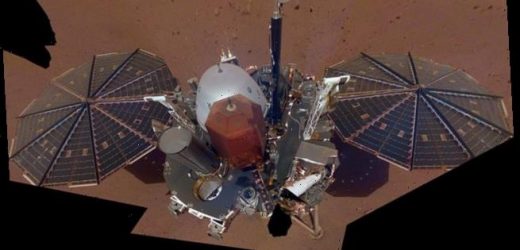NASA Insight’s ‘Mole’ bites the dust: Mars digger is declared dead after failing to burrow deep enough into the Red Planet to take its temperature after two years
- InSight arrived on Mars in November 2018 with a range of scientific instruments
- Instruments included a seismometer, temperature probe and weather station
- German scientist have been trying to get the heat probe into the soil two years
- They hoped to have it drilled down 16 feet to get a temperature reading for Mars
- Unfortunately the soil was different to what they predicted and so it could never take hold in the red dirt enough to drill more than a few feet into the crust
NASA has declared the ‘Mole’ on its InSight lander – designed to borrow deep inside Mars and take his temperature – dead after just two years of operations.
Scientists in Germany hoped to get their 16in heat probe – dubbed the mole – to drill 16t into the Martian crust – but it could not gain enough friction in the red dirt.
Following one last unsuccessful attempt to hammer itself down Into the Martian soil over the weekend, involving 500 strokes, the German team called it quits.
‘We’ve given it everything we’ve got, but Mars and our heroic mole remain incompatible,’ said the German Space Agency’s Tilman Spohn
Scientists in Germany hoped to get their 16in heat probe – dubbed the mole – to drill 16t into the Martian crust – but it could not gain enough friction in the red dirt
The effort will benefit future excavation efforts at Mars, said Spohn, as they discovered that not all motion soil is the same consistency.
Astronauts one day may need to dig into Mars in search of frozen water for drinking or making fuel – or even for signs of past microscopic life.
The mole’s design was based on Martian soil examined by previous spacecraft. That turned out to be nothing like the clumpy dirt encountered this time.
InSight (short for Interior Exploration using Seismic Investigations, Geodesy and Heat Transport) arrived on Mars in November 2018.
The mole was one of three key instruments on the lander, the others included a seismometer and a pair of radio antennas.
InSight’s French seismometer is still going strong. It has so far recorded nearly 500 Marsquakes since since the first discovery that Mars was geologically acted in 2019.
Most of these are tiny, smaller than anything that would be felt on earth, but a couple of been up to nearly magnitude four and have been traced back to the source.
The lander’s weather station is also still providing daily reports on the Martian weather, and sending them back to Earth for analysis.
On Tuesday, the high was -8C (17F) and the low was -49C (-56F) at Mars’ Elysium Planitia, an equatorial plain.
NASA’s InSight lander arrived on Mars in 2018, but its ‘Mole’ probe has had difficulty drilling beneath the surface
The lander was recently granted a two-year extension for scientific work, with its operations now lasting until the end of 2022.
InSight will be joined on Mars by NASA;s newest rover, Perseverance, which will attempt a touchdown on February 18.
One of perseverance is missions is to search for signs of ancient life on the red planet, it will also take samples of rocks and leave them in tubes to be collected later and eventually returned to earth by a future European space agency mission.
The Curiosity rover has been roaming Mars since 2012, and is still in operation, sending back pictures of the red planet showing us what it looks like.
WHAT ARE INSIGHT’S THREE KEY INSTRUMENTS?
The lander that could reveal how Earth was formed: InSight lander set for Mars landing on november 26th
Three key instruments will allow the InSight lander to ‘take the pulse’ of the red planet:
Seismometer: The InSight lander carries a seismometer, SEIS, that listens to the pulse of Mars.
The seismometer records the waves travelling through the interior structure of a planet.
Studying seismic waves tells us what might be creating the waves.
On Mars, scientists suspect that the culprits may be marsquakes, or meteorites striking the surface.
Heat probe: InSight’s heat flow probe, HP3, burrows deeper than any other scoops, drills or probes on Mars before it.
It will investigate how much heat is still flowing out of Mars.
Radio antennas: Like Earth, Mars wobbles a little as it rotates around its axis.
To study this, two radio antennas, part of the RISE instrument, track the location of the lander very precisely.
This helps scientists test the planet’s reflexes and tells them how the deep interior structure affects the planet’s motion around the Sun.
Source: Read Full Article





